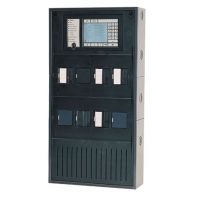Brand : Bosch
Model: FAP-425-DOT-R
Country of Origin: GERMANY
Features:
- Highly reliable and accurate thanks to Intelligent
Signal Processing (ISP)
- Earliest detection of lightest smoke with dual optical
Versions (Dual-Ray technology)
- Monitors environment for electromagnetic influence
For fast root-cause analysis
- Automatic and manual addressing
AVENAR detector 4000 is a new range of automatic fire
detectors featuring a superb accuracy and swiftness in
detection. The versions with two optical sensors
(dual‑optical) are able to detect the lightest smoke.
The range includes versions with rotaries, manually
and automatically addressable, and versions without
rotaries for automatic address setting.
Sensor technology and signal processing
The individual sensors can be configured manually, or
timer-based via the LSN network.
All sensor signals are analysed continuously by the
internal evaluation electronics (ISP - Intelligent Signal
Processing) and are linked with each other via an
inbuilt microprocessor. The link between the sensors
means that the combined detectors can also be used
where light smoke, steam or dust must be expected
during the course of normal operation.
Only if the signal combination corresponds to the
characteristics of the application site, selected during
the programming, the alarm is triggered automatically.
This results in less false alarms.
In addition, the time of the sensor signals on fire and
fault detection is analysed, which leads to high
detection reliability for each individual sensor.
In the case of the optical and chemical sensor, the
response threshold (drift compensation) is actively
adjusted. Manual or time-controlled switch-off of
individual sensors is required for adjustment to
extreme interference factors.
Optical sensor (smoke sensor)
The optical sensor uses the scattered-light method.
An LED transmits light to the measuring chamber,
where it is absorbed by the labyrinth structure. In the
event of a fire, smoke enters the measuring chamber
and the smoke particles scatter the light from the LED.
The amount of light hitting the photo diode is
converted into a proportional electrical signal.
The dual-optical versions use two optical sensors with
different wavelengths. The Dual-Ray technology works
with an infrared and a blue LED so that lightest smoke
is detected fast and reliably (TF1 and TF9 detection).
Thermal sensor (temperature sensor)
A thermistor in a resistance network is used as a
thermal sensor from which an analog-digital converter
measures the temperature-dependent voltage at
regular intervals.
Depending on the specified detector class, the
temperature sensor triggers the alarm status when the
maximum temperature of 54 °C or 69 °C is exceeded
(thermal maximum), or if the temperature rises by a
defined amount within a specified time (thermal
differential).
Further characteristics
• A red flashing LED visible 360° indicates the alarm.
• Connection to a remote indicator is possible.
• The strain relief for cables in false ceilings prevents
the cables from being unplugged accidentally from
the terminals after installation. The terminals for
cable cross-sections up to 2.5 mm2 are very easily
accessible.
• The detectors have a dust-repellent labyrinth and cap
construction. The chamber maid plug (an opening
with closing plug) on the bottom is used to clean the
optical chamber with compressed air (not required
for the heat detector).
• The detector bases no longer have to be directed due
to the centralized position of the individual display.
They also have a mechanical removal lock (can be
activated and deactivated).
Improved LSN features
AVENAR detector 4000 offers all the features of the
improved LSN technology:
• Flexible network structures, including T‑tapping
without additional elements (no T-tapping feasible for
versions without rotaries)
• Up to 254 LSN improved elements per loop or stub
line
• Automatic or manual detector addressing, with or
without auto-detection
• Power supply for connected elements via LSN bus
• Unshielded fire detection cable can be used
• Cable length up to 3000 m (with LSN 1500 A)
• Backwards compatibility to existing LSN systems and
central units
• Monitoring of environmental electromagnetic impact
for fast root-cause analysis (EMC values are displayed
on the panel)
In addition, the range offers all the established
benefits of LSN technology. The panel programming
software can be used to change the detection
characteristics of the respective room utilization. Each
configured detector can provide the following data:
• Serial number
• Contamination level of the optical section
• Operating hours
• Current analog values
– Optical system values: current measured value of
the scattered light sensor; the measuring range is
linear and shows different degrees of pollution,
from slight to heavy.
– Contamination: the contamination value shows
how much the current contamination value has
increased relative to the original condition.
– CO value: display of the currently measured value
(max. 550).
The sensor is self-monitoring. The following errors are
indicated on the fire panel:
• Fault indication in the event of the failure of the
detector electronics
• Continuous display of contamination level during
Service
• Fault indication if heavy contamination is detected
(instead of triggering a false alarm)
In the event of wire interruption or short-circuit,
integrated isolators maintain the functional security of
the LSN loop.
In the event of an alarm, individual detector
identification is transmitted to the fire panel.


















